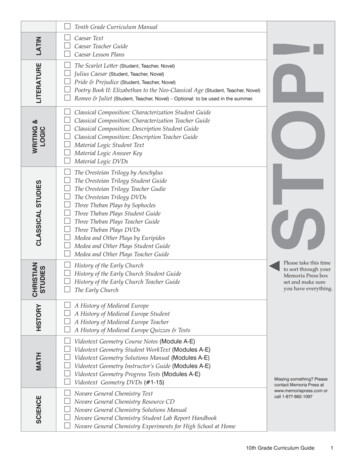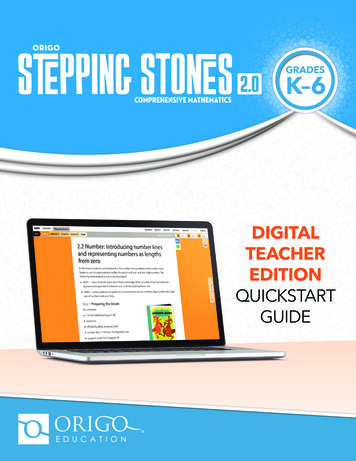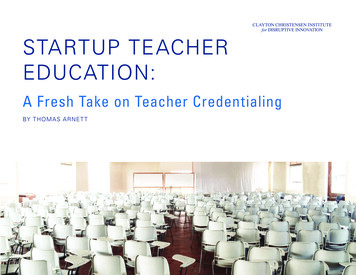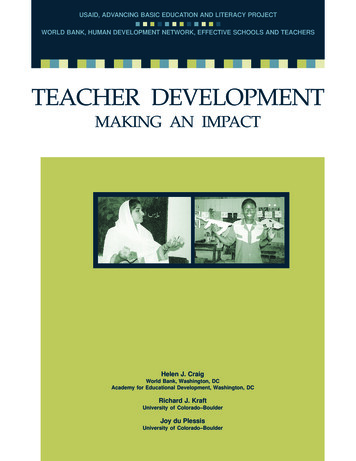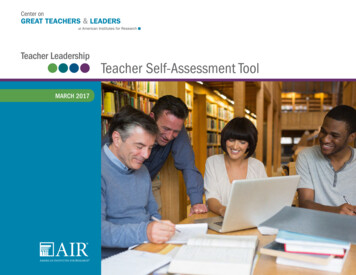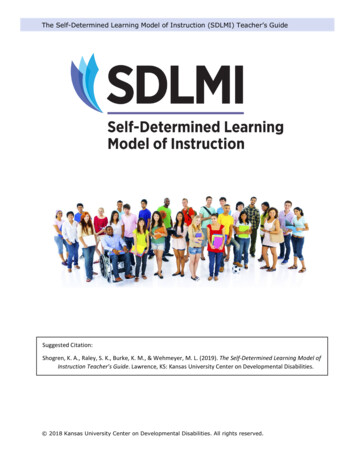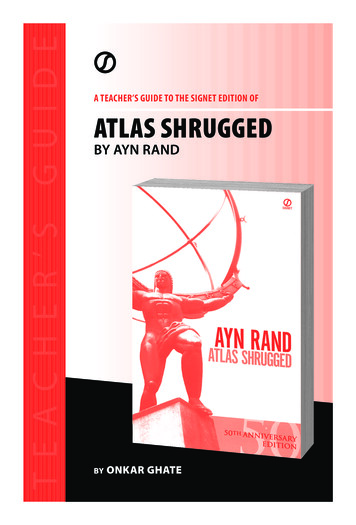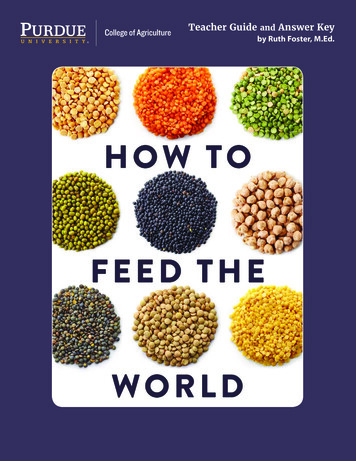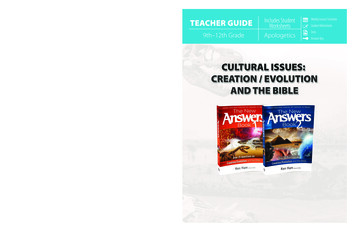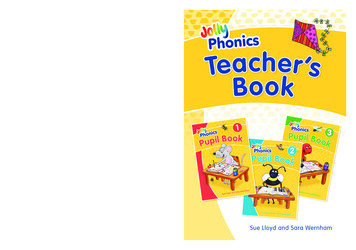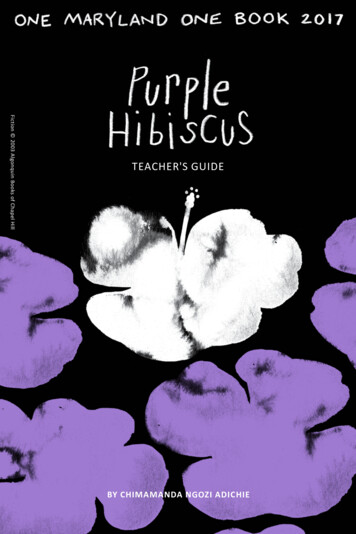
Transcription
Fiction 2003 Algonquin Books of Chapel HillTEACHER'S GUIDEBY CHIMAMANDA NGOZI ADICHIE
WHAT IF EVERYONE READ THE SAME BOOK AT THE SAME TIMETHEN CAME TOGETHER TO TALK ABOUT IT?When we read a great book, we can’t wait toshare the experience and talk about it withothers. That’s one of the joys of reading.In this spirit, Maryland Humanities createdOne Maryland One Book to bring togetherdiverse people in communities across thestate through the shared experience ofreading the same book. Now in its tenth year,One Maryland One Book remains Maryland’sonly statewide community reading program.Each year, the selection process is guided bya theme. The theme for 2017 is “Home andBelonging.”The Maryland Center for the Book at MarylandHumanities partners with public libraries,high schools, colleges and universities,museums, bookstores, correctional facilities,and other organizations to bring bookcentered discussions and other relatedevents to communities across Maryland. ButOne Maryland One Book is not just aboutreading or literature; it is also about bringingpeople together for meaningful dialogue.The book selected for 2017 is Purple Hibiscusby Chimamanda Ngozi Adichie.REACH OUTEach year, more than 10,000 Marylandersread the One Maryland One Book selection.How many of those people are your friendsor family? How many are perfect strangersyou sit next to on the train or stand in linewith at the grocery store? Use the book tojump-start a meaningful conversation withan old friend or to make a new one.PULL UP A CHAIRWe invite you to join Maryland Humanitiesand thousands of Marylanders at one of themany book discussions and related eventshappening around the state in Septemberand October, including an author tour.To find One Maryland One Book programs inyour area, go to www.onemarylandonebook.organd click on Events.For all the latest information, “like” or follow B YOUR COPYFind a copy of Purple Hibiscus at your locallibrary or bookstore and get reading!What if a copy of Purple Hibiscus finds you?If you’re out and about, you might find copies of the book in unexpected places. OurWandering Books can be found in a myriad ofpublic spaces from bus stops to county fairs.If you find a copy, it’s yours for a short time.Register the book online so we can see howfar it travels (instructions are included insidethe book), read it, review it, and then leaveit for someone else to find and enjoy.LET TER FROM MARYLAND HUMANITIESBOARD CHAIR AND EXECUTIVE DIRECTORLook for Chimamanda Ngozi Adichie at severalvenues in late September, including the BaltimoreBook Festival on Sunday, September 24.Thank you for joining Maryland Humanities as we embark on the tenth year of One MarylandOne Book, our state’s largest reading and discussion program. Since the program’s launch in2008, readers across Maryland have embraced our annual tradition of bringing people togetherfrom across the state through the reading of one book, selected by a dedicated group of literaryenthusiasts. Each year we explore the power of literature with fellow readers—from book clubsat workplaces and libraries to students in high school and college. This shared experience lies atthe heart of One Maryland One Book. Whether you’ve read with us every year or are new to theprogram, welcome!This year’s book offers Marylanders a glimpse into the lives and home of a post-colonial Nigerianfamily. The first novel by acclaimed author Chimamanda Ngozi Adichie, Purple Hibiscus weaves agripping tale through the teenage narrator, Kambili, who takes us into the life of a prominent andwealthy Nigerian family with a private secret—a successful and devoutly religious yet physicallyand psychologically abusive father. While a continent away, the story of Kambili and her family iswretchedly familiar. In the U.S., it’s not difficult for any of us to identify someone we know whohas experienced the fear and oppression of abuse. As Kambili comes of age, she and her brotherexperience respite at their aunt’s house, where there is a freedom and warmth absent under thestrict dictates of their father. The contrasts between those homes is striking, but a glimmer ofhope remains as the siblings discover more about themselves and about life as the story buildsto a dramatic crescendo.We encourage you to pick up a copy of Purple Hibiscus and join the conversation at one of ourmany public discussion programs across the state. A program of the Maryland Center for theBook at Maryland Humanities, One Maryland One Book is made possible each year through thegenerosity of our sponsors and community partners. We greatly thank them for their support.Find out how to get involved at www.onemarylandonebook.org.Sincerely,Stephen Sfekas, Board ChairPhoebe Stein, Executive Director1
ABOUT THE AUTHORAPPLICABLE MARYLAND STATE DEPARTMENT OF EDUCATION COMMON CORE STANDARDSChimamanda Ngozi Adichie is the leading African writer of her generation. She grew up onthe campus of the University of Nigeria, Nsukka, and left Nigeria for the U.S. at the age of 19.RH.11-12.1 Cite specific textual evidence tosupport analysis of primary and secondarysources, connecting insights gained from specificdetails to an understanding of the text as a whole.Among her many accolades, Ms. Adichie has been awarded a Hodder fellowship at PrincetonUniversity (2005-2006) and a fellowship at the Radcliffe Institute of Harvard University(2011-2012). In 2008, Ms. Adichie earned a coveted MacArthur Genius Award.Ms. Adichie’s work is read around the world, and has been translated into over thirtylanguages. Her first novel Purple Hibiscus won the Commonwealth Writers’ Prize, and hersecond novel, Half of a Yellow Sun, won the Orange Prize (now the Bailey’s Women’s Prize),which is the world’s top prize for female writers. Her 2013 novel Americanah has receivednumerous accolades, including the National Book Critics Circle Award. It was named one ofThe New York Times Top Ten Best Books of the Year.Ms. Adichie has been invited to speak around the world. Most notably her 2009 TED Talk,The Danger of A Single Story, is now one of the top ten most-viewed TED Talks of all time,with over five millions views. Her 2012 TED talk, We Should All Be Feminists, has a started aworldwide conversation about feminism, especiallyafter it inspired a song by Beyoncé. It was publishedas a book in 2014.Her most recent book, Dear Ijeawele, or a FeministManifesto in Fifteen Suggestions, was published inMarch 2017.Ms. Adichie is committed to assisting youngaspiring writers. As one of her commitments, sheleads an annual Writers Workshop in Nigeria, forwhich applications come from around the world.ABOUT THE BOOKFifteen-year-old Kambili and her older brotherJaja lead a privileged life in Enugu, Nigeria.They live in a beautiful house, with a caringfamily, and attend an exclusive missionaryschool. They’re completely shielded from thetroubles of the world. Yet, as Kambili revealsin her tender-voiced account, things are less perfect than they appear. Althoughher Papa is generous and well respected, he is fanatically religious and tyrannicalat home—a home that is silent and suffocating. As the country begins to fall apartunder a military coup, Kambili and Jaja are sent to their aunt, a university professoroutside the city, where they discover a life beyond the confines of their father’sauthority. Books cram the shelves, curry and nutmeg permeate the air, and theircousins’ laughter rings throughout the house. When they return home, tensionswithin the family escalate, and Kambili must find the strength to keep her lovedones together. Purple Hibiscus is an exquisite novel about the emotional turmoil ofadolescence, the powerful bonds of family, and the bright promise of freedom.RH.11-12.2 Determine the central ideas orinformation of a primary or secondary source;provide an accurate summary that makes clearthe relationships among the key details and ideas.RH.11-12.3 Analyze a complex set of ideas orsequence of events and explain how specificindividuals, ideas, or events interact and developover the course of the text.RH.11-12.4 Determine the meaning of words andphrases as they are used in the text, includingfigurative, connotative, and technical meanings;analyze how an author uses and refines themeaning of a key term or terms over the courseof a text.SL.11-12.1 Initiate and participate effectively in arange of collaborative discussions (one-on-one, ingroups, and teacher-led) with diverse partners ongrades 11-12 topics, texts, and issues, building onothers’ ideas and expressing their own clearly andpersuasively.SL.11-12.1C Propel conversations by posing andresponding to questions that probe reasoningand evidence; ensure a hearing for a full rangeof positions on a topic or issue; clarify, verify, orchallenge ideas and conclusions; and promotedivergent and creative perspectives.SL.11-12.3 Evaluate a speaker’s point of view,reasoning, and use of evidence and rhetoric,assessing the stance, premises, links among ideas,word choice, points of emphasis, and tone used.RH.11-12.7 Integrate and evaluate multiplesources of information presented in diverseformats and media (e.g., visually, quantitatively, aswell as in words) in order to address a question orsolve a problem.SL.11-12.4 Present information, findings, andsupporting evidence, conveying a clear anddistinct perspective, such that listeners can followthe line of reasoning, alternative or opposingperspectives are addressed, and the organization,development, substance, and style are appropriateto purpose, audience, and a range of formal andinformal tasks.RL.1 Cite strong and thorough textual evidence tosupport analysis of what the text says explicitly aswell as inferences drawn from the text.W.11-12.1 Write arguments to support claims in ananalysis of substantive topics or texts, using validreasoning and relevant and sufficient evidence.RL.2 Determine two or more central ideas of a textand analyze their development over the course ofthe text, including how they interact and buildon one another to produce a complex analysis;provide an objective summary of the text.W.11-12.2 Write informative/explanatory texts toexamine and convey complex ideas, concepts andinformation clearly and accurately through theeffective selection, organization, and analysis ofcontent.RL.3 Analyze how the author unfolds an analysisor series of ideas or events, including the orderin which the points are made, how they areintroduced and developed, and the connectionsthat are drawn between them.W.11-12.3 Write narratives to develop real orimagined experiences or events using effectivetechnique, well-chosen details, and well-structuredevent sequences.RL.4 Determine the meaning of words andphrases as they are used in the text, includingfigurative and connotative meanings; analyze theimpact of specific word choices on meaning andtone, including words with multiple meanings orlanguage that is particularly fresh, engaging, orbeautiful. (Include Shakespeare as well as otherauthors.)RL.6 Determine an author’s point of view orpurpose in a text and analyze how an author usesrhetoric to advance that point of view or purpose.W.11-12.4 Produce clear and coherent writing inwhich the development, organization, and styleare appropriate to task, purpose, and audience.W.11-12.6 Use technology, including the Internet,to produce, publish, and update individual orshared writing products in response to ongoingfeedback, including new arguments or information.W.11-12.9 Draw evidence from literary orinformational texts to support analysis, reflection,and research.3
SPECIAL NOTES:Teachers and students should be aware that Purple Hibiscus contains scenes of physical and psychologicalabuse. Teachers may want to prepare students to expect this content and follow up with additional discussionoutside of the content offered in this guide as needed.An extensive supplemental guide with additional before and after reading activities; glossary of Igbo words,names, and phrases; and other activities is available online at www.onemarylandonebook.org under HowTo Participate. We hope that these materials will enhance students’ experience with and understanding ofPurple Hibiscus.CHARACTERS: Kambili Achike — Narrator and central character in novelEugene “Papa” Achike — Kambili and Jaja’s fatherBeatrice “Mama” Achike — Kambili and Jaja’s mother; wife of EugeneChukwuka “Jaja” Achike — Kambili’s older brother by about two yearsAunty Ifeoma — Eugene’s sister; widowed with three childrenAmaka — Aunty Ifeoma’s eldest daughter; 15 years oldObiora — Aunty Ifeoma’s son; 14 years oldChima — Aunty Ifeoma’s youngest child; 7 years oldFather Amadi — A young, attractive priest; close with Aunty Ifeoma’s familyPapa-Nnukwu — Eugene and Ifeoma’s father; rooted in traditional non-Christian beliefs ofhis indigenous cultureFather Benedict — White, British-born head of St. Agnes ChurchAde Coker — Editor of newspaper the Standard owned by Papa AchikeYewande Coker — Wife of Ade Coker; has two young childrenSisi — Servant girl in the Achikes’ homeKevin — The Achikes’ driverPart I: Geography and DefinitionsDIRECTIONS: Use your own searching skills to answer the following questions.1 In what part of Africa is Nigeria located?2 What are the names of the three ethnic groups that make up the majority of Nigeria’s population?3 Define the term colonialism.Part II: The Igbo CultureDIRECTIONS: Go to the following website about Igbo o.dir/Culture/culture and socialization.htmlUse the information you find there to take notes in the following chart to determine themain characteristics of the Igbo culture in pre-Colonial Nigeria. Use bullet points and puteverything in your own words!ELEMENT OF THE IGBO CULTURENOTESReligion & beliefsWomen & familyTraditions & ritualsLaw & justicePart III: ColonizationGENERAL THEMES:DIRECTIONS: Go to the following website about colonialism in Africa:Religion, wealth, power, corruption, political instability, effects of violence, personal udents/curriculum/m7b/activity2.phpchallenges of adolescenceUse the information you find there to respond to the following questions.BEFORE READING ACTIVITIES:Visit www.onemarylandonebook.org and click on How To Participate to download this activityin handout format.WEB QUEST: CULTURAL AND HISTORICAL CONTEXT FOR PURPLE HIBISCUSOBJECTIVE: Students will analyze web-based documents in order to determine the causesand effects of colonialism in Africa.DIRECTIONS: Complete the following Web Quest as a way of gaining background knowledgewhich will help you understand the context and content of the novel we will be studying,Purple Hibiscus.1 Why did Europeans first go to Africa?2 What is nationalism? What are some of the negative aspects of nationalism?3 How did European colonists view themselves?4 Why did some missionaries support European colonization of Africa?5 Explain how the following approaches allowed European nations to rule over Africa:Economic Companies:Direct Rule:Indirect Rule:Settler Rule:Part IV: Closing QuestionDIRECTIONS: Respond to the following question after completing the Web Quest.Based on the background knowledge you acquired today regarding the Igbo culture andEuropean colonization, what conflicts or disagreements do you imagine would have arisenbetween the two groups (the Igbo and the Europeans) during the period of colonization?What misunderstandings may have occurred between the two groups?5
Chapter 1 (pages 3-16): The very first line begins with an allusion to the novel Things Fall Apart by Chinua Achebe,which portrays the clash between Nigeria’s white colonial government and the traditionalculture of the indigenous Igbo people. What is the significance of Adichie starting thisnovel with such an allusion? What mood does it create for the beginning of the story? The narrator describes the religious traditions her family follows every Palm Sunday.Reread the first paragraph, analyze the significance of the characters who are participatingin the traditions of Palm Sunday, and predict what those roles might mean throughout thenovel. The narrator describes her mother’s actions after Papa breaks the figurines and addsimagery of her mother two weeks prior “when her swollen eye was still the black-purplecolor of an overripe avocado ” (10-11). What can we infer from this description ofKambili’s mother? What can we infer from the casual way Kambili inserts this description? What is the purpose and effect of the following simile that the narrator uses to describeJaja’s defiance toward his father: “Jaja’s defiance seemed to me now like Aunty Ifeoma’sexperimental purple hibiscus: rare, fragrant with the undertones of freedom, a differentkind of freedom from the one the crowds waving green leaves chanted at GovernmentSquare after the coup. A freedom to be, to do”? (16).Chapter 2 (pages 19-26): The paragraph immediately after Kambili and Jaja scrubbing Mama’s blood off of the flooris about an execution that was shown on television. What is the significance of this eventand the characters’ reaction to it following what they just witnessed with their parents? For what, in Papa’s eyes, did Mama need to be forgiven? What is ironic about Papa’s beliefsand his actions?Chapter 4 (pages 37-51): Why was Ade Coker arrested? What are the implications of his arrest in regards to theHead of State using violence to suppress and discourage free speech? Does suppression offree speech happen in today’s society? Explain. Adichie uses the rhetorical device anaphora, or the repetition of a word or phrase at thebeginning of successive clauses, when she writes “I needed him to touch the back of myneck ” and “I need him to hug me ” and “I needed him to smile at me ” (39). What is thepurpose and effect of this device? What mood does Kambili’s statement, “I was stained by failure,” create for the reader? (39).Have you ever felt this way about yourself? Explain. How is the theme of perception versus reality reflected through Kambili and her classmates?How is it reflected through the Achike family thus far in the novel? Because the Igbo are a patriarchal society, marriage holds the utmost significance inorder to procreate and continue the family line. However, it is common for a man who hasa barren wife to procreate with a woman other than his wife, or even take a secondwife. Why is it significant that Mama pointed out Papa’s rejection of other women to herown children? (20). What does the reader learn about Mama’s character through thesecomments?Chapter 5 (pages 52-70): What does the reader learn about Kambili’s perception of Mama and Papa’s love for oneanother? (21). Why is this significant for the reader? Several times throughout the chapter Papa is called “omelora,” or “The One Who Does forthe Community” by the villagers (56). Why is he so revered in Abba? Do you think Papagains something internally from their admiration? Explain. The military coups of Nigeria were both successful and unsuccessful since the country’sindependence from the British Empire in 1960. The coups discussed in the novelwere a permanent feature of Nigerian culture from 1966-1999. What did Papa meanwhen he stated “But what we Nigerians needed was not soldiers ruling us, what we neededwas a renewed democracy”? (25).Chapter 3 (pages 27-36): Adichie makes it clear in this chapter that Nigeria is now ruled by a military regime, andtherefore the soldiers can act with exemption from punishment. How is the theme offreedom versus tyranny illustrated through Kambili’s thoughts and comments in thischapter? Analyze the impact of the following simile: “Silence hung over the table like the blue-blackclouds in the middle of rainy season” (32). What tone does it create and why is it significant? Kambili describes her determination to be the first in her class as “balancing a sack ofgravel” on her head every day at school and “not being allowed to steady it” with herhand (52). What things in your life have you had to balance to achieve something betterfor yourself? Can you empathize with the pressure Kambili feels she is under? What is the significance of Papa’s silence when Ade Coker said, “Imagine what the Standardwould be if we were all quiet”? (58). Why are Kambili and Jaja instructed to stay at Papa-Nnukwu’s house for only 15 minutes?What does Papa’s traditionalist father constantly remind him of? Discuss how the impact of colonialism becomes evident throughout the chapter, includingthe economic divide between the classes.Chapter 6 (pages 71-88): Aunty Ifeoma comes to visit and when speaking to Mama, calls her “nwunye m,” or “mywife” (73). Why is it significant that she accepts Mama in such a way? What does Papa’sreaction to that term of endearment tell the reader about his beliefs?7
Why is Aunty Ifeoma’s “fearlessness” uncomfortable and forbidding to Kambili? (76). Howdoes Kambili’s outlook about Papa change when Ifeoma is interacting with him? How doesshe disrupt the order of Papa’s family? List several examples found throughout the chapter that reflect the economic differencesbetween Papa’s family and Aunty Ifeoma’s family. Why is it important to note thesedifferences? What can the reader infer about Kambili’s views about these differencessurrounding her family? Similar to her classmates, Kambili’s cousin Amaka takes her silence and reserve for privilegeand snobbishness. Is there some truth to Amaka’s and her classmates’ assumption? Whyis Kambili unable to speak when faced with someone who expresses herself? Before picking up Papa-Nnukwu to join on the trip to Ezi Icheke, Kambili explains to heraunt that Papa does not want them to have a relationship with their grandfather becausehe is a pagan, to which Aunty replies that he is “not a pagan,” but a “traditionalist” (81).Research the difference between paganism and traditionalism in the Igbo culture andanalyze why it was important for Aunty to clarify the difference.Chapter 7 (pages 89-109): As Mass ends, Papa donates money to fund the priest’s new house, and after his donationamount is announced, Papa left “smiling and waving at the many hands that reached outto grasp his white tunic as if touching him would heal them of an illness” (91). Analyze thesymbolic figure he seems to represent and the irony of this symbolic depiction. Explain Kambili’s metaphorical statement: “I felt, looking at her, that I was helplesslywatching precious flaxen sand slip away between my fingers” (93). What theme does thisfigurative language develop? The first revealing example of Papa’s violence occurs when Mama, Jaja, and Kambili arebeaten for breaking the Eucharistic fast before church. After the beating, Papa “crushed”Jaja and Kambili into his body to hug them and asked if the “belt hurt” (102). Why doesAdichie utilize the word “crushed” to describe a hug? What are other word choices duringthat violent incident that help create the author’s tone? Predict what the following statement foreshadows: “Papa called Aunty Ifeoma two dayslater. Perhaps he would not have called her if we had not gone to confession that day. Andperhaps then we would never have gone to Nsukka and everything would have remainedthe same” (104). What is the significance of Father Benedict’s eyes being described as “the same greenshade of a snake ”? (105). When Jaja and Kambili discuss wanting to go to Nsukka, why does her throat tighten “atthe thought of five days without Papa’s voice, without his footsteps on the stairs”? (108).Chapter 8 (pages 110-139): What has the reader learned about Kambili thus far through the way she perceives hersurroundings and through other people’s views of her? Does the way Kambili narratesthe story affect the reader’s perception of Nigeria and the Igbo people? Provide severalexamples from this chapter for support. What are some examples of Amaka’s rejection of the Eurocentric colonial mindset? Whymight her viewpoint be significant in relation to the previous question? When Aunty Ifeoma laughed about the schedule Papa gave his children to follow whilevisiting, Kambili’s “mouth felt dry,” her “tongue clinging to the roof” of her mouth (124).Why does Kambili yearn for the strict order and silence of her home? How do the familydynamics differ in each household, and why are the differences significant? Why are Aunty Ifeoma’s hibiscuses purple, rather than another color? Of what are they aresult? Why is their existence significant to the story thus far? One of the best-known Nigerian musicians is Fela Ransome Kuti, who Amaka playsfor Kambili. Kuti, who was educated in England, created Afrobeat, a style of music thatblends jazz with traditional African rhythms. He railed against the colonial mentality of hisupbringing and advocated for a return to both traditions and democracy. He was arrested,beaten, and tortured several times for openly criticizing the government. The popularity ofhis music was seen as a threat to the military establishment. Why is it significant thatAmaka listens to this type of music rather than the popular music of the time? Does thismake her an activist? (Background and link to his music: 833/biography)Chapter 9 (pages 140-161): What is the opening mood of this chapter, and how is it created by the author? Aunty Ifeoma suggests that Kambili read a book titled Equiano’s Travels, or the Life ofGustavus Vassa the African (143), also titled The Interesting Narrative and Other Writingsby Olaudah Equiano. Research the summary of this novel and then determine why Kambili’saunt might have chosen this specific text for her to read. What is the significance of Aunty Ifeoma stating to Jaja “Defiance is like marijuana—it isnot a bad thing when it is used right” when discussing the legendary king of ethnicNigerians Jaja of Opobo? (144). Aunty Ifeoma covers for Jaja when Chima asks him about his deformed finger (145).However, Kambili wonders how her aunt knows about the incident, and Jaja says whenAunty asked, he told her the truth. What is peculiar about Kambili’s thoughts regardingtelling the truth about these situations? Why does she want to remain loyal to her family’ssecret? How is the motif of governmental corruption interspersed throughout this chapter?Cite several examples, then analyze how the lack of a democratic government directlyimpacts the rights of the people.9
When the family is dining with Papa-Nnukwu, Obiora comments that “Morality, as well asthe sense of taste, is relative” (156). Knowing Papa-Nnukwu’s beliefs, do you think heagrees with this notion? Would Papa agree with this? Would Mama? Explain your responsesfor each character.Chapter 10 (pages 162-205): When describing the lumps of fufu that Aunty Ifeoma uses to “bury” Papa-Nnukwu’stablets in, the image the narrator uses to compare them to is “spherical coffins” (163).Why is this word choice significant? After Kambili calls Papa-Nnukwu a heathen again, Aunty Ifeoma wants her to see hergrandfather’s rituals and to teach her about his faithfulness to his traditionalist beliefs(167-168). How do Kambili’s views change after watching the full ritual? Explain. Throughout the novel thus far, Adichie explores the oppressive nature of religion, notonly on an individual’s soul, but also on the hypocritical inclinations in religious groups.Although there are many instances of religious compromise and tolerance, some of thecharacters struggle with their views. Based on what you have read thus far, what stance dothe following characters take on organized religion and why? Papa-Nnukwu, FatherAmadi, Obiora, Amaka, Aunty Ifeoma, and Papa. Analyze Kambili’s internal dialogue when she states: “She seemed so happy, so at peace,and I wondered how anybody around me could feel that way when liquid fire was raginginside of me, when fear was mingling with hope and clutching itself around my ankles”(174). How does the conversation with Father Amadi at the football field open the door forKambili to question her father’s rules? Cite examples for support. What is significant about Kambili and Jaja’s reaction to Papa-Nnukwu’s death? Are theirreactions expected or unexpected?Chapter 11 (pages 206-216): After Ade Coker’s assassination, Kambili starts to have violent nightmares (207). What issymbolic about Kambili replacing herself in the nightmare for Ade’s daughter, and herfather for Ade? What does Papa mean when he says there are “fake pastors at those mushroom Pentecostalchurches”? (208). What can the reader infer about Papa’s beliefs and his hypocriticalnature? What do Mama’s figurines, Kambili’s painting, and Jaja’s purple hibiscus provide for allthree characters in a world of unhinged violence? What actions and internal dialogue reflect a change in Kambili’s feelings toward her fatherafter the violent incident that almost killed her?Chapter 12 (pages 217-239): After Kambili and Jaja are sent to Aunty Ifeoma’s so she can heal, Kambili observes severalaspects of nature, such as “the smell of freshness in the air” due to rain, and the air “fillingwith flapping, water-colored wings” (218). Why are her descriptions of nature emphasizedin the first few pages of the chapter, given what she has just experienced with her father? Amaka asks Kambili if it was her father who hurt her and, for the first time, she admits tothe truth. Why won’t Kambili look at Amaka to see her reaction to this response? DoesPapa still have “control” over her? Kambili overhears Aunty Ifeoma and her friend discussing the leadership at the university,and Obiora explains, “The university becomes a microcosm of the country” (224). Lookup the definition of microcosm and analyze what Obiora means in regards to the spreadof tyranny. Why is Aunty Ifeoma’s house searched? Why is she warned by the special security men to“be careful”? (231). What
in her tender-voiced account, things are less perfect than they appear. Although her Papa is generous and well respected, he is fanatically religious and tyrannical at home—a home that is silent and suffocating. As the country begins to fall apart under a military coup, Kambil
